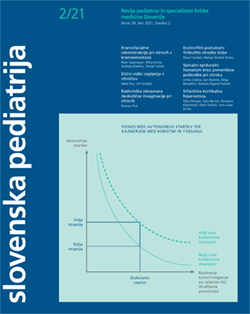
|
Article short contents
Slovenska pediatrija 2021; 28: 67-77
https://doi.org/10.38031/slovpediatr-2021-2-01en
|
: 1933
Original scientific article
CRANIOFACIAL RECONSTRUCTIONS IN CHILDREN WITH CRANIOSYNOSTOSIS
Peter Spazzapan
Enota za pediatrično nevrokirurgijo, Klinični oddelek za nevrokirurgijo, Univerzitetni klinični center Ljubljana, Ljubljana, Slovenija
Miha Kočar
Klinični oddelek za maksilofacialno in oralno kirurgijo, Univerzitetni klinični center Ljubljana, Ljubljana, Slovenija
Andreja Eberlinc
Klinični oddelek za maksilofacialno in oralno kirurgijo, Univerzitetni klinični center Ljubljana, Ljubljana, Slovenija
Tomaž Velnar
Enota za pediatrično nevrokirurgijo Klinični oddelek za nevrokirurgijo, Univerzitetni klinični center Ljubljana, Ljubljana, Slovenija
Abstract
Background. Craniosynostosis is a group of rare congeni-tal diseases of the skull. They arise from premature ossification of one or more cranial sutures. This represents an obstruction to normal brain growth and leads to specific deformations of the skull, which may in the long term cause intracranial hypertension and cognitive delay.
Materials and methods. All children treated for craniosyn-ostosis in the Paediatric Neurosurgery Unit of the University Medical Centre Ljubljana between June 2015 and September 2020 (N = 71; age 12.8 years; follow-up 2.7 years) were analyzed. The following data were recorded: affected suture, syndromic condition, hydrocephalus, Chiari malformation, raised intracranial pressure, age at surgery, surgical technique, need for multiple operations, and surgical complications. Results. Sagittal synostosis were present in 54.9 %, 25.3 % metopic, 14 % unicoronal, 1.4 % bicoronal and 1.4 % unilateral lambdoid. Multiple sutures were affected in 2.8 % of cases. Seven % were syndromic. Overall, 74 surgical procedures were performed: fronto-orbital advancement in 40.5 % of cases; biparietal remodelling in 32.4 %; total cranial vault remodelling in 22.9 %; posterior distraction in 2.7 %; posterior expansion in 1.3 %. Conclusions. The treat-ment of craniosynostosis is exclusively surgical and requires a multidisciplinary, neurosurgical, maxillofacial surgical and plastic and reconstructive surgical approach. Surgical treat-ment is performed not only for aesthetical purposes, but mainly to permit normal development of the brain.
Key words: craniosynostosis, intracranial hypertension, apnoea, hydrocephalus, Chiari malformation